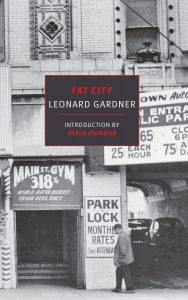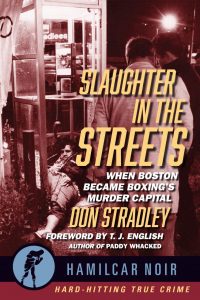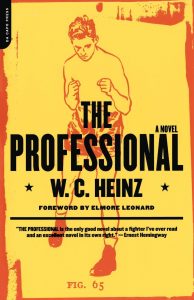When I chose to feature boxing in my debut thriller, Undercard, people asked, why not mixed martial arts, seemingly the more popular combat sport of the day? The simple answer is I have a greater passion for boxing, having watched it since I was a child and trained in it a little. But to dig deeper, there is a history to boxing that few sports come close to matching. Depicted in artwork as far back as the 3rd Millennium BC, popular in Ancient Greece and Rome, with news records of bare-knuckle fights in England dating as far back as the late 1600s, boxing connects us to cultures of the past, to the early days of spectator sports. It also connects us with the history of Las Vegas, where Undercard is set, boxing a featured attraction in the casino resorts, from the days of mob-run gambling to the commercialized spectacles of the present. Boxing is an urban sport, linked to urban issues: the struggles in the ring reflect the struggles of the marginalized and impoverished. Struggle is at the core of Undercard, which attempts to engage with urban issues through the story of a high-profile prizefight, as have a great many books, all finding fertile soil in the inherent drama of boxing. Here is a list of books that deal with a sport that has left an indelible mark on literature, from the ancient classics to contemporary works.

The Sweet Science, A.J. Liebling
For insight into the history of boxing, this is the book. The title, The Sweet Science, refers to the Sweet Science of Bruising, an affectionate moniker that, like this book, captures not only the artistry and technical savvy of boxing but also its toughness and brutality. In this series of essays for The New Yorker from the 1950s, Liebling writes, “The Sweet Science is joined onto the past like a man’s arm to his shoulder.” This is a window into a period when boxing was in decline, between the heyday of the 1920s and 30s and the magnetism of Muhammad Ali electrifying the world in the 1960s and 70s, which mirrored the decline of the inner city as resources were diverted to the suburbs.

The Aeneid, Virgil
Boxing does appear in The Iliad, in Book 23: Funeral Games for Patroclus, a brief but vicious bout, detailed in one verse, for the somewhat surprising prize of a draft mule. But Virgil explores pugilism a little deeper than does his predecessor Homer. While the boxing scene in The Aeneid is only about 160 lines in Book V: Games and a Conflagration, a tiny fraction of the epic poem, I wanted to include this ancient classic on the list for its window into how similar boxing matches were fought and perceived in ancient societies in relation to today—and also, for evidence of how long the visceral nature of boxing has been used by writers to create excitement in readers. This passage goes into great detail about the oxhide gloves the fighters wear, and is the story of an old champion taking on a brash young challenger in his final bout, a classic boxing trope, told with the immediacy and riveting pace of all The Aeneid’s action scenes, to make you think it was written after the advent of fast-cut filmmaking instead of thousands of years ago.

Fat City, Leonard Gardner
Fat City is a novel that explores the allure of boxing as salvation to inner city young men, and ultimately how elusive that salvation is, even if there is some success in the ring. Leonard Gardner writes about training, sparring, and fights, but much of this book is devoted to the incredible difficulty of overcoming obstacles created by poverty. Substance abuse and depression are significant themes in the novel, examined not only in those suffering but also in those trying to help those suffering: the character of the boxing trainer who attempts, often futilely, to support wayward young people is resonant in a time when so many lose their lives to mental health issues.

Slaughter in the Streets: When Boston Became Boxing’s Murder Capital, Don Stradley
When I trained for a period in a high-performance gym inside Toronto’s main tennis stadium, walking down the sleek, cavernous halls of this building, eerily empty and quiet when no tournament was on, I couldn’t stop thinking about setting a story in halls like these. Having a major sports event take place, but the real story, the real action, going on here, buried inside the stadium in these futuristic tunnels. It would be years before I realized this idea in Undercard, where violence is not confined to the ring. Slaughter in the Streets, by Don Stradley, is another book that stands at the intersection of boxing and murder. These are the true-crime stories of men in Boston in the first half of the 20th century who dreamed of being great fighters but couldn’t make it past the fringe of the sport, and in their desperation chose criminal plots, resulting in grim ends. Boston itself, morphing into something new, in part by the violent actions of these boxer criminals, is a key feature of the book, which demonstrates that the confluence of boxing, poverty, crime, and the urban landscape is not the realm of fiction alone.

Inside Fighter: Dave Brown’s Remarkable Stories of Canadian Boxing, Tom Henry
Boxing history and cultural history once again converge in this quaint, albeit rough, book of Canadian boxing anecdotes. In Inside Fighter, Tom Henry provides snapshot after snapshot into the lives of boxers and the sphere that encompasses them through the eyes of Dave Brown, whose entire professional life has revolved around boxing, as a fighter, manager, and judge, a sort of seen-it-all done-it-all character giving the inside scoop on a world most of us have only a glimpse of. Much of the 20th century is touched upon, with references even to 19th century bouts: “In 1886, two BC boxers participated in one of the longest matches in Canadian prizefighting history … for the championship of Vancouver Island on a rocky shelf on the shores of Pedder Bay.” In this one line you have the rugged romanticism of both boxing and Canada combined; this book a subjective lens but an evocative one.

The Professional, W.C. Heinz
In W.C. Heinz’s novel The Professional, we are given an inside look at what it’s like on the cusp of a world championship, where the years of toil and blood serve only to create the opportunity: the real prize must still be won, and will take greater effort than all that led up to it. With a terse, gritty style and keen attention to detail, Heinz takes us on a tour of all the tough and eccentric characters of the boxing world, from the fighters and trainers to the journalists and promoters, and captures the pain and obsession of having a goal that supersedes all else.

Chuvalo: A Fighter’s Life: The Story of Boxing’s Last Great Gladiator, George Chuvalo, Murray Grieg
Here are all the issues previously discussed epitomized in one person, as well as all the gruesomeness and thrills found inside the ring. Chuvalo, the autobiography of hall-of-fame heavyweight George Chuvalo, known for being able to withstand punishment against greats like Ali, Foreman, and Frazier, identifies a key aspect of boxing: “you have to know real poverty to want to earn your living as a fighter.” While this statement is not always the case, in my research for Undercard I repeatedly came across stories of such destitution and pain, from multiple lost loved ones to homelessness, as to make me think that if an athlete has an opportunity in any other sport they will probably take it. Pain is in full supply in Chuvalo, as he recounts how Joe Frazier’s explosive left hooks smashed his eye socket to the point that his eye was protruding, with another epic left hook landing on the eyeball itself (the referee thankfully stopped the fight for fear that Chuvalo would be blinded). He also recounts how three sons and his wife died of drug overdoses and suicide.

Men Without Women (“Fifty Grand”), Ernest Hemingway
As maybe the most famous writer who is associated with boxing, Ernest Hemingway had to make this list. His short story collection Men Without Women contains in it the story “Fifty Grand,” indicative of both Hemingway’s signature, paired-down, tough prose and the hard-boiled toughness of so many boxing stories. Here again are the themes that define the boxing genre, drawn from the true events of the 1920s that surrounded Hemingway at the time of its writing: the aging fighter literally and figuratively against the ropes battling a younger challenger; the wisecracking, street-savvy hangers on; the pull of criminals, gambling and money troubles, and boxing as the tantalizing mirage of every kind of salvation; and most of all the endurance of pain in the ring in pursuit of a greater goal beyond it. Perhaps in that last respect boxing is not so different from writing.

















